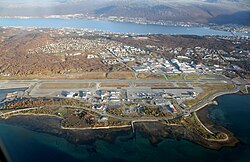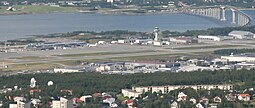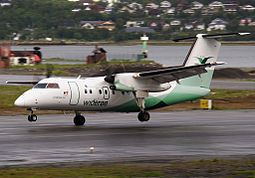Tromso Airport
| Tromso Airport | |
|---|---|

|
|
| Characteristics | |
| ICAO code | ENTC |
| IATA code | TOS |
| Coordinates | |
| Height above MSL | 10 m (33 ft ) |
| Transport links | |
| Distance from the city center | 3.1 km northwest of Tromso |
| Street | Fylkesvei 862 |
| Basic data | |
| opening | September 14, 1964 |
| operator | Avinor |
| Passengers | 2,271,748 (2017) |
| Air freight | 2,912 t (2014) |
| Flight movements |
47,543 (2017) |
| Start-and runway | |
| 01/19 | 2447 m × 45 m asphalt |

The Tromso airport or the airport Tromso Langnes ( Norwegian Tromsø lufthavn, Langnes ; IATA: TOS , ICAO: ENTC ) is located near Langnes to the west of the island Tromsøya , 3.1 km northwest of the center of Tromso on the west side of the island in the Fylke Troms og Finnmark in Norway . The airport is the largest airport in North- Norway with 2,271,748 passengers in 2017.
The airport serves Tromsø as well as parts of the Troms region . It is an important stopover for flights to numerous airports in Finnmark , although most passengers travel via Oslo . Many of the flights serve destinations in Norway , including Longyearbyen on Svalbard . However, there are also some international destinations, including Arkhangelsk , Murmansk and London . There are also some charter flights to destinations in southern Europe and the Canary Islands .
history
The first airport in Tromsø was a water landing site on Skattøra, at that time in the independent municipality of Tromsøyasund . It was set up in the 1930s and operated by Det Norske Luftfartselskap . During the Second World War , the airport was taken over by the Air Force and expanded. A new seaplane route to Trondheim using a Junkers Ju 52 was introduced in 1946, which a few months later was extended north to Kirkenes .
The operation of the water airport was handed over by the Norwegian Air Force to the municipalities of Tromsø and Tromsøysund. They built a new shipyard and a new terminal building. The airport was operated by both communities on a per capita basis. From 1947 new, faster aircraft ( Short Sandringham ) were put into operation and a direct connection to Oslo was introduced, with a travel time of eight hours. With the opening of Bodø Airport , the Junkers Ju 52s were put back into operation. This was done until 1956 when Bardufoss Airport opened. Passengers from Tromsø were brought to the airport by bus.
The Norwegian Civil Aviation Authority came to the conclusion in 1950 that Tromsø, as North Norges largest city, should have an airport. Parliament decided in 1953 that a new airport should be built near Langnes. Local politicians, however, felt that Bardufoss was a permanent solution. Nevertheless, it was decided to build a new airport. The municipality spent 350,000 Norwegian kroner on expropriations . Originally they wanted to build a 1400 meter long runway, but this would have meant that the largest machines would not have been able to land. That is why they wanted to build a 1,600 meter long track. After this was decided, there were plans to build a 2000 meter long runway, which were then implemented.
The airport was opened on September 14, 1964 and served by Scandinavian Airlines System (SAS) using Sud Aviation Caravelle aircraft. Tromsø Airport became the base for flights to Finnmark. The SAS made a stopover in Tromsø on all flights to Finnmark. The airport also became the base for flights to Longyearbyen on Svalbard . The airport was later expanded to become the main airport in the Troms region . In 1965 the airport recorded 20,177 passengers. Since a network of regional airports in Vesterålen and Finnmark was established during the 1970s , the number of passengers in Tromsø increased: in 1975 there were 214,135 passengers and in 1990 there were already 564,540 passengers.
The original terminal building was replaced by a semicircular one in 1977. The current building was built in 1998 as part of the expansion and renovation of the airport. The airport received a new tower and, for the first time, passenger boarding bridges .
Airlines and Destinations
Passenger flights
| Airlines | Destinations |
|---|---|
| BH Air | Seasonal (charter): Burgas |
| Finnair operated by Flybe Nordic | Seasonal: Helsinki-Vantaa (from January 1, 2014) |
| Helvetic Airways | Seasonal: Zurich |
| Jet2.com | Seasonal (charter): Manchester |
| Lufthansa | Frankfurt am Main , Munich (seasonal) |
| Nordavia | Arkhangelsk-Talagi , Murmansk |
| Norwegian Air Shuttle |
Alicante , Alta , Bodø , Gran Canaria , Kirkenes , London-Gatwick , Oslo-Gardermoen , Trondheim Charter: Antalya , Chania |
| RusLine | Seasonal: Moscow-Domodedovo |
| Scandinavian Airlines |
Alta , Bodø , Longyearbyen , Oslo-Gardermoen , Trondheim Seasonal: Stockholm / Arlanda Charter: Chania , Palma de Mallorca |
| Widerøe's Flyveselskap | Alta , Andenes-Andøya , Bergen , Båtsfjord , Berlevåg , Hammerfest , Harstad / Narvik , Hasvik , Honningsvåg , Kirkenes , Lakselv , Mehamn , Sandefjord-Torp , Stokmarknes-Skagen , Sørkjosen , Vadsø , Vardø |
| Wizz Air | Gdansk (from December 16, 2017) |
Cargo flights
| Airlines | aims |
|---|---|
| West Atlantic Sweden for the Norwegian Post | Harstad / Narvik , Bodø , Oslo-Gardermoen , Longyearbyen |
Traffic figures


| year | Passenger volume | Air freight ( tons ) (with airmail ) |
Aircraft movements (with military) |
|---|---|---|---|
| 2017 | 2,271,748 | - | 47,543 |
| 2016 | 2,104,861 | - | 43,763 |
| 2015 | 2,009,146 | - | 42,444 |
| 2014 | 2,006,924 | 2,912 | 43,723 |
| 2013 | 1,936,022 | 2.162 | 42,000 |
| 2012 | 1,889,023 | 2,622 | 40,439 |
| 2011 | 1,800,093 | 2,766 | 39,484 |
| 2010 | 1,649,584 | 2,636 | 38,873 |
| 2009 | 1,629,967 | 3.117 | 38,774 |
| 2008 | 1,647,504 | 3,221 | 39,736 |
| 2007 | 1,246,289 | 3,266 | 40,063 |
| 2006 | 1,557,255 | 5,197 | 40,053 |
| 2005 | 1,123,257 | 5,410 | 37,860 |
| 2004 | 1,147,692 | 5,211 | 37.195 |
| 2003 | 1,348,962 | - | 36,301 |
| 2002 | 1,377,722 | 5,629 | 34,232 |
| 2001 | 1,549,176 | 6.252 | 37,858 |
| 2000 | 1,552,888 | 6,671 | 37,625 |
| 1999 | 1,587,154 | 7,060 | 41,783 |
Busiest routes
Incidents
- On September 12, 1972, a Lockheed C-130K Hercules of the British Royal Air Force ( registration number XV194 ) fell off the runway on landing and crashed into a ditch. All inmates survived; the machine has been irreparably damaged.
- On July 17, 1973, a Convair CV-640 of the Swiss SA de Transport Aérien (SATA) ( aircraft registration HB-IMM ) hit the runway violently on landing and jumped into the air again. At the second impact - on the nose landing gear - it collapsed. All 60 occupants survived the accident. The aircraft was totaled.
Web links
- Official website of the airport (English, Norwegian)
- Official website of the airport operator (English, Norwegian)
- Tromso Airport on ippc.no
- Aeronautical map on skyvector.com
- Airport data in the Aviation Safety Network (English)
Individual evidence
- ↑ a b c d e f g Statistics. Avinor.no , accessed November 19, 2018 .
- ↑ accident report C-130K XV194 , Aviation Safety Network (English), accessed on August 14, 2018th
- ^ Accident report CV-640 HB-IMM , Aviation Safety Network (English), accessed on August 14, 2018.

